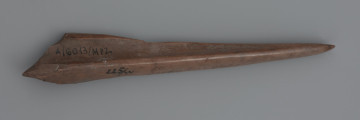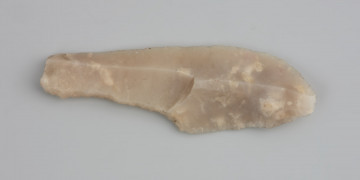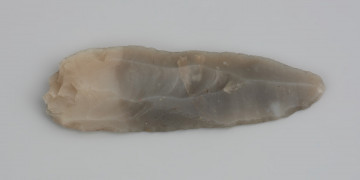
Perforator
9600 p.n.e. — 4100 p.n.e.
National Museum in Szczecin
Part of the collection: Bronze Age
The necklace currently consists of 23 pendants, and initially, there were over fifty. This unusual decoration was made of the so-called white bronze, an alloy with a high tin content, thanks to which an incredible effect of oxidised silver was obtained. Each pendant has a long, curved spike resembling a bear's fang. The creator was likely to be inspired by the teeth of a wild animal. The so-called cone-shaped pendants are among the finds that are characteristic of the area of Western Pomerania. They were used for a long time, about 400 years (from the end of the 1st to the 1st half of the 3rd Bronze Age; approx. 1500-1200 BC). These are products of local origin, which testify to the excellent skills of local bronzers. Such pendants are usually found singly in both graves and hoards. The necklace from Brzeźniak is unique. It was discovered in 1895 by Johannes Stützner, a pastor from Karwowo, during amateur excavations carried out in connection with repairing a road between Brzeźniak and Drawsko. The necklace, five earthenware vessels, and the remains of an ornamented bronze bowl on a leg was found in a barrow grave, which was tightly covered with a "mantle" of fieldstones. The finder donated the content of the grave to the museum collection of the Society of History and Antiquities of Pomerania (Towarzystwo Historii i Starożytności Pomorza) in Szczecin.
Dorota Kozłowska
Author / creator
Dimensions
the entire object:
Object type
pendant, collar necklace, body adornment
Technique
casting
Material
tin bronze
Origin / acquisition method
legal transfer
Creation time / dating
Creation / finding place
Owner
National Museum in Szczecin
Identification number
Location / status

9600 p.n.e. — 4100 p.n.e.
National Museum in Szczecin

11900 p.n.e. — 11000 p.n.e.
National Museum in Szczecin

11900 p.n.e. — 11000 p.n.e.
National Museum in Szczecin
DISCOVER this TOPIC
National Museum in Szczecin
DISCOVER this PATH
Educational path